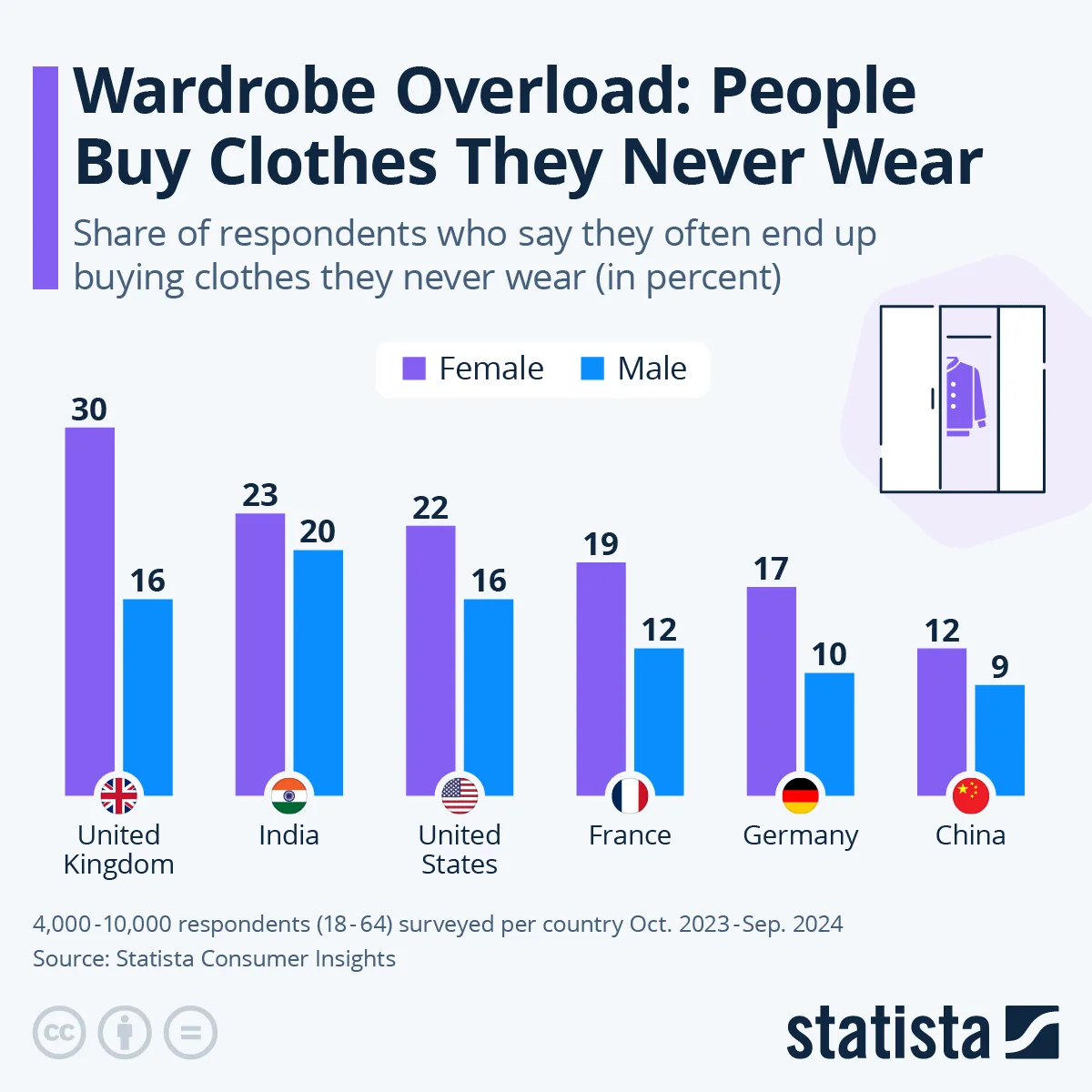Select Language:
The Phenomenon of Wardrobe Overload in Modern Consumer Society
Understanding Wardrobe Overload
Wardrobe overload refers to the accumulation of clothing items that consumers purchase but never wear. This phenomenon has gained significant attention, particularly during shopping events like Black Friday and Cyber Monday, which have transformed into extended shopping weeks characterized by rampant consumerism.
The Impact of Shopping Events
As retail businesses capitalize on these shopping holidays to maximize profits, consumers often find themselves caught in a cycle of impulsive buying. Discounts and promotions can create a false sense of urgency, leading individuals to purchase items they may not need or fully appreciate. The frenzy of sales can obscure the practicality of each potential purchase, pushing shoppers to indulge excessively.
Consumer Insights on Clothing Purchases
Recent data from Statista Consumer Insights revealed startling statistics regarding consumer habits related to clothing purchases. The findings indicate a pronounced trend in which many individuals purchase clothing they never wear.
Global Variations in Shopping Habits
The degree of wardrobe overload isn’t uniform across the globe. For instance, female shoppers in the UK show a significant tendency towards unnecessary purchases, with 30% admitting that they often buy clothes they do not use. Conversely, the figure drops to 12% in China, suggesting cultural and economic differences in shopping behavior.
Gender Disparities in Clothing Purchases
Interestingly, the statistics also highlight a gender disparity in the phenomenon of wardrobe overload. In the United States, 22% of women reported frequently buying clothing that ultimately languishes unworn in their closets. In comparison, 16% of men admitted to similar behavior. This difference raises questions about societal expectations, shopping habits, and the emotional ties individuals have with their clothing.
The Economic Impact of Unused Clothing
The economic implications of wardrobe overload are considerable. From a consumer perspective, spending money on clothing that never sees the light of day represents a significant waste of financial resources. Imagine the potential savings if consumers chose to resist impulsive purchases. The adage that the best deal is one not spent rings especially true in this context.
Psychological Influences on Shopping Behavior
Several psychological factors can contribute to wardrobe overload. For many, shopping serves as a form of retail therapy, providing a temporary escape from stress or emotional distress. Additionally, social media influences can amplify the desire to keep up with trends, leading individuals to make purchases based on perception rather than necessity.
The Role of Marketing Tactics
Retailers often employ marketing strategies that exploit these psychological tendencies. Markdowns and limited-time offers can create pressure to buy now, or risk missing out, exacerbating the situation. Shoppers may rationalize unnecessary purchases as a means of securing a good deal, further contributing to wardrobe overload.
Practical Implications of Excess Clothing
The environmental ramifications of excessive clothing purchases cannot be overlooked. The fashion industry is a significant contributor to environmental waste, with unsold garments often ending up in landfills. As awareness of sustainability issues grows, consumers are increasingly called to reflect on their purchasing habits and consider their impact on the planet.
Tips for Responsible Shopping
As consumers become increasingly aware of the issues surrounding wardrobe overload, it’s essential to adopt more mindful shopping practices. Here are a few tips for responsible clothing purchasing:
1. Prioritize Needs over Wants
Before making a purchase, ask yourself if the item fulfills a genuine need. This can help reduce impulsive buying habits.
2. Establish a Budget
Creating a clothing budget can keep spending in check and encourage more thoughtful selections.
3. Embrace Minimalism
Adopting a minimalist approach to fashion can encourage consumers to focus on quality over quantity, leading to a more curated and functional wardrobe.
4. Give Yourself Time to Decide
Implement a waiting period before making a purchase. This allows for reflection and can help diminish impulse buying.
The Bigger Picture of Consumer Responsibility
It’s clear that the phenomenon of wardrobe overload is not just an individual issue but part of a larger systemic challenge within consumer culture. Encouraging mindfulness, prioritizing sustainable practices, and promoting awareness around shopping habits can lead to significant changes in both individual consumer behavior and the broader retail landscape.
Empowering a New Shopping Ethos
In the face of modern temptations and marketing tactics, consumers are encouraged to cultivate a new shopping ethos—one that values mindful consumption over mindless accumulation. By being conscious of their purchasing choices, individuals can not only streamline their wardrobes but also contribute positively to personal finance and the environment.



